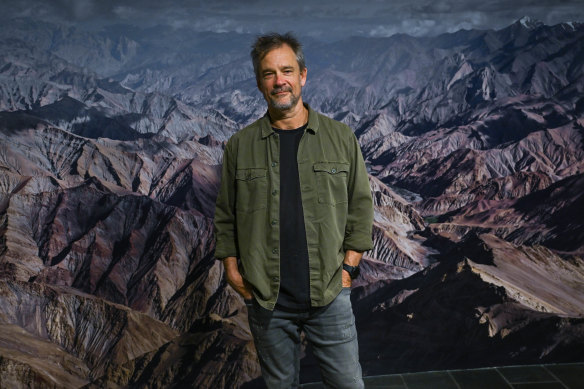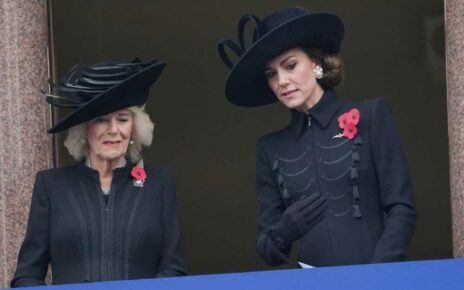By Karl Quinn
Murray Fredericks in front of one of his earliest landscapes, shot in Ladakh.Credit: Jo Armao
Save articles for later
Add articles to your saved list and come back to them any time.
In a room of the Museum of Australian Photography that’s adorned with large-format prints of his work, Murray Fredericks is being accosted by an endless stream of admirers, all eager to tell him how much his abstract landscapes speak to them.
“I’m not necessarily comfortable being the focus of attention,” he tells me. “It’s a bit out of place for a landscape photographer, I can tell you.”
Fredericks is a tall, fit, ruggedly handsome 53-year-old, somewhere between adventurer and, in this space at least, rock star.
The fans have come for the opening of the largest retrospective of his work yet. But while it’s called The Salt Lake in reference to the abstract landscapes created over 33 visits to Lake Eyre over the past 20-odd years, the exhibition also includes a bunch of images that are striking for how little they resemble the pictures that have made him one of the country’s most acclaimed artists.
These are far more traditional prints of mountain ranges, many in black and white, captured in Ladakh and Patagonia and south-west Tasmania at the start of the career he embarked upon in his late 20s after graduating with a degree in politics and economics.
“That was really the formative work,” he says. “I wasn’t trying to push the bounds of landscape photography, I was trying to master what I thought landscape photography was – technically, aesthetically, compositionally, setting up my way of working.”
To capture the shots of the Arthur Range in south-western Tasmania, he hiked in with all his food, his tent and sleeping gear, and a bellows camera. “The starting weight of my pack when I headed off was around 43 or 44 kilos,” he says. “The heaviest I ever went in with was 50 kilos.”
It was, he says, “overly ambitious”. “I only recall taking one of those black and white shots, and I can remember almost every shot I’ve ever taken. But because I was trying to bushwalk – as in get from A to B in a certain time – and to photograph at the same time, that didn’t work. That’s pure exhaustion.”
What those early forays taught him was the value of preparation and patience, which now informs every aspect of his practice.
“I’m hauling equipment up to a point, and then I’m going to rest, and I’m going to sit there until something happens,” he says. Typically, he’ll give it three days. But once he’s invested that much time, it’s tempting to stretch to four or five. “Some of the most pleasurable moments in my life are sitting in locations just waiting for the weather to clear, because it’s just a pure break. There’s no demands on you.”
Taking the black and white Tasmanian shots out of storage 20 years after he last looked at them was “really lovely”, he says, and has prompted his next project. In January, he will head back to Tasmania for what he hopes will be the first of three long hikes into the wilderness over three months. “I’m going in with two of my four boys, Jackson and Finn, age 21 and 17. I’m not sure if they know they have volunteered to help me with the weight, but they have.”
The challenge he has set for himself is to re-engage with a landscape that was such a formative influence on his craft, but this time through the lens (so to speak) of everything he has learnt in the decades since.
“They are very literal shots,” he says of those early pictures. “So I’m going in knowing that’s what I can’t do.
“The challenge is that it’s what I call a very traditional landscape, the landscape almost tells you what you can do there.”
But he’ll be doing his best to resist that diktat, using some “new chromatic technology that turns any vegetation almost white”.
Fredericks says the landscape “is just a tool to create an emotional response in the viewer”.Credit: Joe Armao
Whether desert or mountain, his aim is the same. “I’m obsessed with the nature of our medium, and the nature of photography is that the viewer assumes that it is true,” he says.
But his interventions in the landscape – whether through time lapse, the blurring of horizon and sky, the use of mirrors or, in his recent Blaze series, the introduction of fire (in a controlled way, he hastens to add, that leaves the landscape unharmed) – are all about playing with the boundary between fact and fiction, in service of a greater truth.
“I don’t believe what I’m doing at Lake Eyre is documenting the lake, the geographical nature,” he says. “What I’m trying to do is to convey the emotional quality of my experience, and I’m trying to tap into something universal.”
Everyone responds to images that convey a sense of the infinite, he believes, or to fire. “It might not be the identical response, but I’m pretty sure these things are evolutionary.”
The landscape is his medium; the human response to it is his real subject.
“It’s not a record of the landscape,” he insists. “The landscape is just a tool to create an emotional response in the viewer.”
Murray Fredericks: The Salt Lake is at the Museum of Australian Photography, Wheelers Hill, Melbourne, until February 18, 2024. Murray Fredericks: Blaze is at Arc One, 45 Flinders Lane, Melbourne, until February 3.
Contact the author at [email protected], follow him on Facebook at karlquinnjournalist and on Twitter @karlkwin, and read more of his work here.
Most Viewed in Culture
Source: Read Full Article




